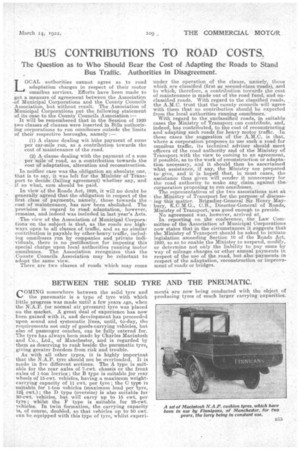BETWEEN. THE SOLID TYRE AND THE PNEUMATIC.
Page 19

If you've noticed an error in this article please click here to report it so we can fix it.
rOMING somewhere leetween the solid tyre and 1-#. the pneumatic is a type of tyre with which little progress was made until a few years ago, when the N.A.F. (or normal air pressure) tyre was placed on the market. A great deal of experience has now been gained with it, and development has proceeded upon sound and systematic lines, until, to-day, the requirements not only of goods-carrying vehicles, but also of passenger coaches, can be fully catered for. The tyre has always been made by Charles Macintosh and Co., Ltd., of Manchester, and is regarded by them as deserving to rank beside the pneumatic tyre, giving greater freedom from risk and trouble.
. As with all other types, it is highly important that the N.A.P. tyre should not be overloaded. It is made in five different sections. The A type is suitable for the rear axles of 7-cwt. chassis or the front axles of 1-ton lorries ; the B type is suitable for rear wheels of 15-cwt. vehicles, having a MaX1112113/1 weightcarrying capacity of 11. cwt. per tyre ; the C type is suitable for 1-ton vehicles (maximum load per 'tyre, 12-i cwt.); the D type (oversize) is also suitable for 20-cwt. vehicles, but will carry up to 15 cwt. per tyre ; whilst the F type is suitable for 25-cwt. vehicles. In twin formation, the carrying capacity is, of course, doubled, so that vehicles op to 50 cwt. can be equipped with this type of tyre, whilst experi
meats are now being conducted with the object of producing tyres of much larger carrying capacities.




























